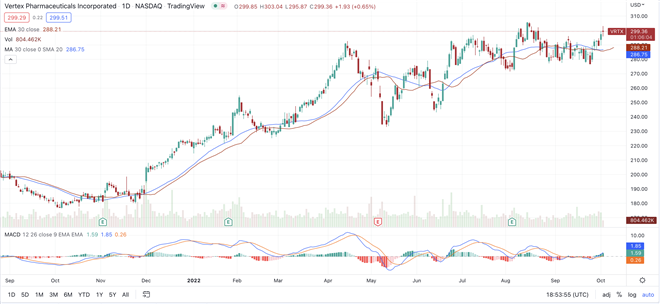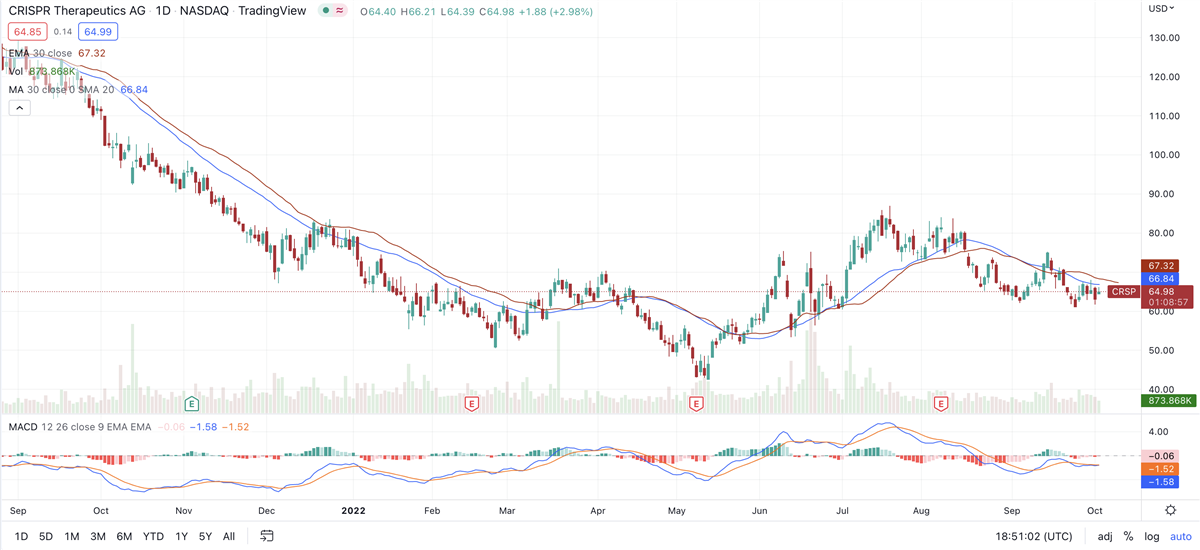 Shares of Vertex Pharmaceuticals (NASDAQ: VRTX) moved more than 2% higher last week and were up another 3.41% so far this week. The bounce followed news that regulators gave the company the go-ahead to begin the review process for a gene-editing treatment for two rare blood conditions.
Shares of Vertex Pharmaceuticals (NASDAQ: VRTX) moved more than 2% higher last week and were up another 3.41% so far this week. The bounce followed news that regulators gave the company the go-ahead to begin the review process for a gene-editing treatment for two rare blood conditions. Vertex partners with CRISPR Therapeutics (NASDAQ: CRSP) to develop exa-cel, the world’s first available therapy using the CRISPR gene editing technology.
Vertex and CRISPR will begin submitting a rolling application to the FDA next month and expect to complete the filing by late March. The two companies began their partnership in 2015.
Vertex is an S&P 500 component, accounting for 0.246481% of index weighting. Vertex Pharmaceuticals stock climbed nearly 5% the day after the company’s second-quarter report in early August. It’s now up 8% since reporting earnings.
Net income came in at $3.60 per share, an increase of more than 2,000% over the year-earlier quarter. The company has been profitable every year since 2016, with analysts expecting earnings of $14.19 for the full year, an increase of 41%. The stock is projected to rise 7% in 2023 to $15.23.
Revenue for the quarter was $2.196 billion, an increase of 22%. The company has a solid track record of double-digit revenue growth, with the three-year sales growth rate at 34%.
In addition to a strong quarterly report, Vertex boosted its full-year revenue guidance by $200 million, adding that it expects sales of cystic fibrosis meds in the range of $8.6 billion to $8.8 billion.
MarketBeat earnings data for Vertex show that the company has a long history of trouncing revenue views, but occasionally misses on the bottom line.
Analysts have a “moderate buy” rating on the stock and a price target of $291.65.
Contributing to Vertex’s revenue expectations is a pipeline of products that includes genetic and other therapies for often difficult-to-treat conditions such as Type 1 diabetes and sickle-cell diseases. 
Vertex partner CRISPR has been in a steep correction since January 2021. It posted a decline of 16.73% year-to-date and a decline of 43.30% on a one-year basis. Shares are currently trading at June 2020 levels.
CRISPR focuses on gene editing for therapeutic applications. Its technology makes precision cuts to DNA to delete and correct genes and then to insert genes to treat certain genetic diseases. Its technologies are especially applicable for developing treatments for rare diseases or other conditions that occur due to genetic mutations — exactly what the partnership with Vertex is designed to accomplish.
CRISPR is in a very different position than Vertex. While the later markets actual pharmaceutical products and generates revenue that way, CRISPR gets its revenue from Vertex, which pays for the technology while the product pipeline continues. CRISPR should be viewed as a speculative stock for the moment.
Although there’s certainly optimism about the Vertex partnership, the stock price hasn’t yet gotten a lift.
Analyst data gathered by MarketBeat show the stock as a “moderate buy,” with a price target of $112.33, a potential upside of 71.27%. It’s important to keep in mind that the estimate applies to the next 12 to 18 months. It’s also contingent upon regulatory approval of the exa-cel treatment with Vertex.
CRISPR is a mid-cap, with a market capitalization of $5 billion. It has a relatively high beta, at 1.52, and a relatively small number of funds holding shares. The float is only 73.3 million, so its ability to be a truly institutional quality stock is limited at the moment.
That could change over time. Companies do grow in market cap and more shares become available. But for now, CRISPR, unlike Vertex, remains in the speculative zone. 





